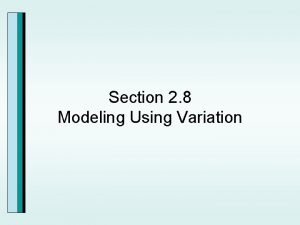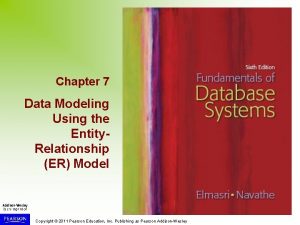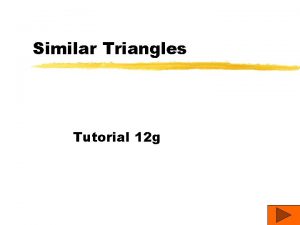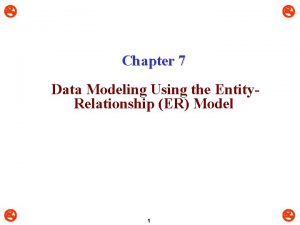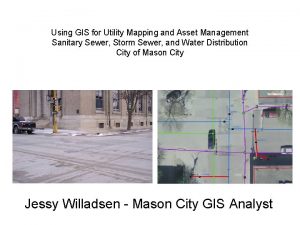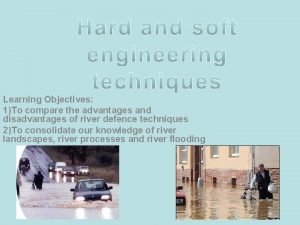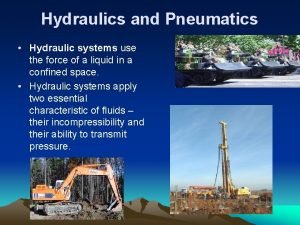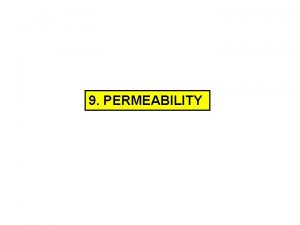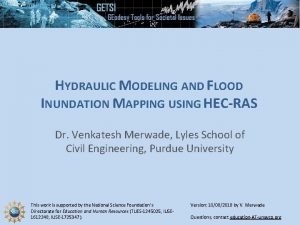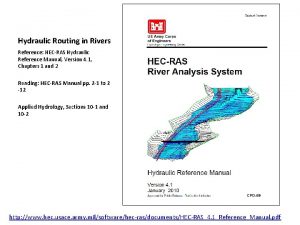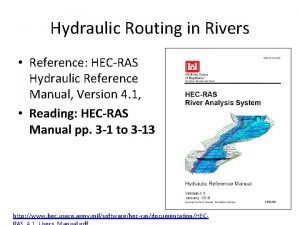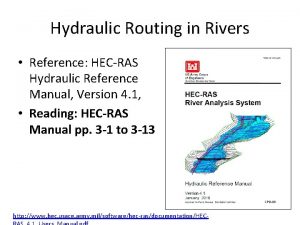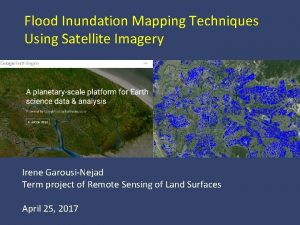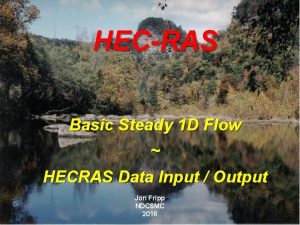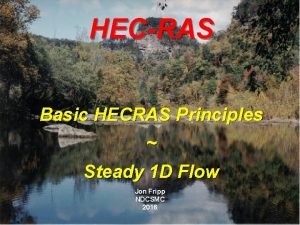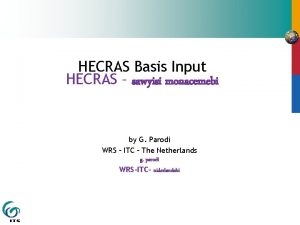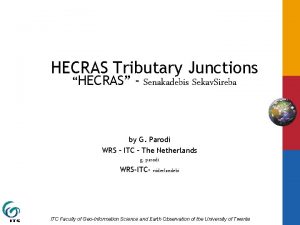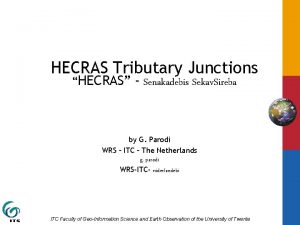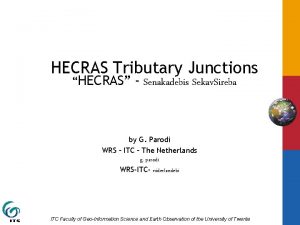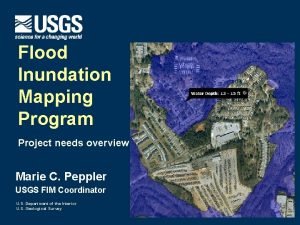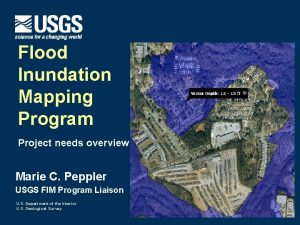HYDRAULIC MODELING AND FLOOD INUNDATION MAPPING USING HECRAS




















- Slides: 20

HYDRAULIC MODELING AND FLOOD INUNDATION MAPPING USING HEC-RAS Dr. Venkatesh Merwade, Lyles School of Civil Engineering, Purdue University This work is supported by the National Science Foundation’s Directorate for Education and Human Resources TUES-1245025, IUSE 1612248, IUSE-1725347, and IUSE-1914915. Version: 10/08/2018 by V. Merwade Questions, contact education-AT-unavco. org

WHAT IS A HYDRAULIC MODEL? • Hydraulic model: A hydraulic model is a mathematical representation of a water/sewer/storm system and is used to analyze the system’s hydraulic behavior. • Hydraulic modeling is frequently used to understand a hydraulic system’s behavior under different scenarios at different spatial and temporal scales. Lab experiment Modeling Cost Time 2

DIFFERENT TYPES OF HYDRAULIC MODELS Hydraulic models can be categorized by its dimensionality 1 D 2 D Flow is considered one dimensional (1 D) both in channel and floodplain 1 D/2 D Combined 1 D-2 D. 1 D in channel and 2 D in floodplain Flow is considered two dimensional (1 D) in both channel and floodplain 3 D Flow is considered three dimensional (3 D) in both channel and floodplain 3

ONE DIMENSIONAL (1 D) HYDRAULIC MODEL A 1 D model assume flow in one direction – generally along the river. Flow alongitudinal direction 1 D Flow along lateral direction is neglected EXAMPLES • HEC-RAS 1 D (Hydraulic Engineering Center-River Analysis Service 1 D Model) • MIKE 11 • SWMM (Storm and water management model) • HY 8 4

HEC-RAS 1 D Developed by U. S Army Corps of Engineering It can be used for the following situations: § Steady or unsteady riverine systems § Flow primarily along one direction § Minimal split flow River centerline, banks and crosssections need to be defined. Calculations are conducted between different two contingent cross sections 5

GOVERNING EQUATIONS 1 D hydraulic models compute cross-sectional average water surface elevation (WSE) and velocity at discrete cross-sections by solving a full version of 1 D Saint-Venant equations using implicit finite difference method. A: cross-sectional area, Q: Discharge, S: frictional slope, z: water depth, x: distance along the flow, f: fraction to determine channel versus floodplain discharge, t: time 6

1 D PROFILE CALCULATIONS 1 2 Plan View Longitudinal view he: head loss, V: velocity, g: gravitational acceleration, L: reach length, a: velocity coefficient 7

LOSS IN ENERGY HEAD LLOB LC LROB Plan View C: contraction/expansion coefficient. Contraction occurs when downstream velocity head is higher and vice versa. Cross-sectional View 8

FLOW CONVEYANCE AND FRICTIONAL SLOPE Computation of flow conveyance (K) and frictional slope (Sf) is based on Manning’s n values. Thus Manning’s n or roughness coefficient plays a critical role in hydraulic modeling. 9

PUTTING IT ALL TOGETHER Y 1 is given. Assume Y 2 Based on Y 1 and Y 2, compute conveyance (K) and friction slope (Sf), and then get he. Use he to compute Y 2. If the error between computed Y 2 and assumed Y 2 is greater than a specified tolerance (e. g. , 0. 01 ft), iterate Y 2 until the error is within tolerance. • If the difference between computed Y 2 and assume Y 2 is within the specified tolerance, Y 2 becomes Y 1 and the computations move upstream. • • 10

DATA REQUIREMENTS • River Channel description – Length and slope the reach – Channel and floodplain roughness – Cross-section geometry • Boundary Conditions • Flow and/or stage data at upstream and downstream locations • Structure geometry – – Bridges Culverts Weirs Levees, etc

GETTING RIVER DESCRIPTION A Digital Elevation Model (DEM) or Triangulated Irregular Network (TIN) is needed to extract cross-sections for HEC-RAS 12

CREATING GEOMETRY IN RAS MAPPER

GEOMETRY DATA PLAN VIEW Cross-section Bank locations Station number River or stream Junction

GEOMETRY DATA – CROSS SECTIONAL VIEW Station or distance along XS Elevation values along XS

STEADY FLOW DATA – UPSTREAM BOUNDARY CONDITION Flow value is specified at the upstream of each reach. Multiple values can be specified to create multiple profiles.

STEADY FLOW DATA – DOWNSTREAM BOUNDARY CONDITION Water depth (known water surface elevation, critical depth or normal depth) can be provided as downstream boundary for each reach

RUNNING SIMULATION AND VIEWING RESULTS Steady flow analysis editor Cross-sectional view Profile view of results XYZ view

FLOOD INUNDATION MAP

HEC-RAS LAB • You are provided with a HEC-RAS model for Wabash-Tippecanoe confluence in West Lafayette, IN • Run the model for different return periods ranging from 2 to 500 -year and create flood inundation maps using RAS Mapper • All instructions are provided in the handout
 Hec-2 download
Hec-2 download Helen c. erickson
Helen c. erickson Dimensional modeling vs relational modeling
Dimensional modeling vs relational modeling Memory parameters
Memory parameters Forward mapping vs backward mapping
Forward mapping vs backward mapping Prinsip analisis dan desain
Prinsip analisis dan desain Modeling using variation calculator
Modeling using variation calculator Data modeling using entity relationship model
Data modeling using entity relationship model Lesson 12 modeling using similarity
Lesson 12 modeling using similarity Modeling of digital communication systems using simulink
Modeling of digital communication systems using simulink Modeling of digital communication systems using simulink
Modeling of digital communication systems using simulink Er model diagram
Er model diagram Utility mapping using gis
Utility mapping using gis Flood storage areas advantages and disadvantages
Flood storage areas advantages and disadvantages What did spanish settlers hope to find in venezuela
What did spanish settlers hope to find in venezuela Hydraulic conductivity equation
Hydraulic conductivity equation Spears oilfield market report 2017
Spears oilfield market report 2017 Introduction to hydraulics and pneumatics
Introduction to hydraulics and pneumatics Hydraulic conductivity to permeability
Hydraulic conductivity to permeability Continuity equation hydrology
Continuity equation hydrology Hydraulic circuit for drilling machine
Hydraulic circuit for drilling machine






